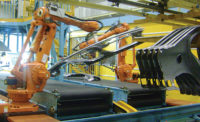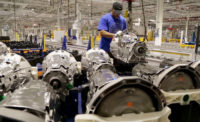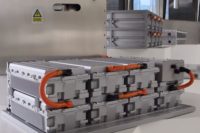FOSHAN, China—Some 100 six-axis robots weld, bond and package EV batteries at the FAW-Volkswagen Automobile Co. Ltd. assembly plant here. The factory produces 300,000 battery packs annually.
FAW-Volkswagen is a joint venture between the Volkswagen Group and China FAW Group Corp. Ltd., a Chinese automobile manufacturer headquartered in Changchun. It is the second largest of the “Big Four” state-owned carmakers in China, together with SAIC Motor, Dongfeng Motor Corp. and Changan Automobile.
The Foshan plant is one of the most automated, flexible and productive facilities in VW’s global network, manufacturing both electric and gas-powered vehicles. The plant includes four automated lines for stamping, welding, painting and final assembly.
The most recent addition to the plant is the “MEB Smart Factory,” which was built specifically to produce VW’s MEB platform, a modular base for EVs. The platform is used by Audi, SEAT, Škoda and Volkswagen, along with Ford through partnership. As of 2023, the MEB platform underpins nine models, including the Audi Q4 e-tron, Škoda Enyaq iV, VW ID.6 and Ford Explorer. According to VW, the architecture was designed to “consolidate electronic controls, reduce the number of microprocessors, advance the application of new driver-assistance technology, and alter the way cars are built.”
For VW, the Foshan plant is a reference factory for EVs and a flagship for automation, smart production and digitalization for the global automotive industry.
The plant can produce more than 600,000 vehicles annually, and that number is expected to increase to 770,000 by 2024.
Some 80 percent of the battery pack line is automated. The line includes technology for high-speed riveting and contrast-free online measurement. Vision-guided robots perform welding, adhesive dispensing, packaging and testing operations. For safety, infrared sensors continuously monitor the temperature of batteries during assembly and test operations.
Since 2018, the Foshan factory has received nine national environmental awards for green and energy-saving production methods. More than 200,000 square meters of solar panels generate 9,000 megawatt-hours of renewable energy per year. Some 44 percent of the water used in the production process is recycled.


